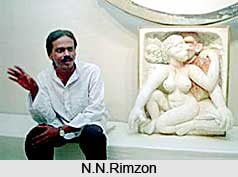 N.N.Rimzon was born in Kakkoor, Kerala in 1957. He completed his B.A. in sculpture from the College of Fine Arts, Trivandrum. Thereafter he did his M.A. in 1982 at M. S. University, Baroda. He was highly influenced by the leftist background in Kerala and the socio- political strife at the time of the Emergency. He was also inspired by Ramkinker Baij. In 1989 Rimzon obtained an M.A. with distinction from the Royal College of Art, London.
N.N.Rimzon was born in Kakkoor, Kerala in 1957. He completed his B.A. in sculpture from the College of Fine Arts, Trivandrum. Thereafter he did his M.A. in 1982 at M. S. University, Baroda. He was highly influenced by the leftist background in Kerala and the socio- political strife at the time of the Emergency. He was also inspired by Ramkinker Baij. In 1989 Rimzon obtained an M.A. with distinction from the Royal College of Art, London.
His sculptures are arranged in an installation-like space and stimulated by discontinuities, suggestiveness and contradictions of size, colour, setting. He directs the viewer to a complex experience of his imagination mingled with that of the artist. He relies on indigenous classic art forms of aesthetic, emotive, symbolic, personal, contemporary and utilitarian ones. His approach is post-modernist as well as essentially Indian at a time of cultural and social transition. Rimzon`s later work was rooted in specific classic forms and has a greater simplicity and immediate power.
Society fragmentation, individual alienation and archetypal depictions of the human experience dominate his work. His metal, fiberglass and stone sculptures have won him international acclaim.
Rimzon`s solo shows were held at Art Heritage, New Delhi 1991, 93, School`s Gallery, Amsterdam 1994. The main participation`s are: Seven Young Sculptures, New Delhi 1985, 1 00 years of Indian Art, National Gallery of Modem Art, New Delhi 1994, Art and Nature, New Delhi 1995, The Other Self, New York and Stadelijk Museum, Amsterdam 1995,2ndAsia Pacific Triennale, Brisbane, Fire and Life, New Delhi 1996
Rimzon`s artistic vocabulary is rooted in symbols which are derived from the rural landscape of southern India: the village compound, the palm tree, the temple, the forest pathway and the handmade canoe. Rimzon uses his personal language to construct works along with a narrative suggestion. He skillfully through the combination of various groups of images uses the power of the metaphor to comment on important social issues.
Although figures are devoid in Rimzon`s works, there is a suggestion of human involvement.
His work can be found in the collections of The National Gallery of Modern Art, New Delhi and Mumbai, The Chester Herwitz Trust, Massachusetts, U.S.A., The Foundation for Indian Artists, Amsterdam, and the Art Gallery of New South Wales, Sydney.




















